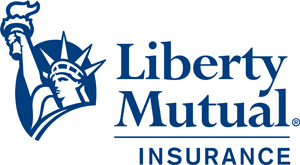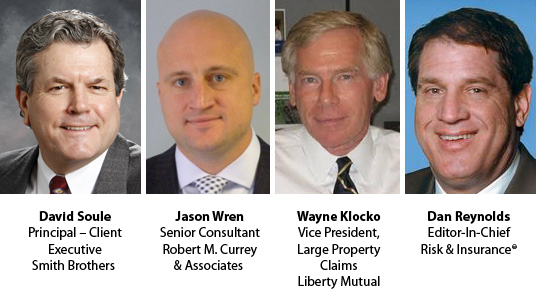Risk Scenario + Webinar
Drenched
Disclaimer: The events depicted in this scenario are fictitious. Any similarity to any corporation or person, living or dead, is merely coincidental.
Wanda on the Way
Jon Fried walked toward the exit of the Grand Opera House in Wilmington, Del. Once he cleared the doorway, he stopped to take in the ocean smells blowing on the breeze. The strong, warm, late-August wind felt good.

The singer-songwriter whose performance he had just seen was one of his all-time favorites; the artist was a peerless lyrical craftsman. Jon should have been happy and at peace, but he wasn’t.
Jon picked up where he had left off before the show — worrying about Caribbean storm Wanda. The storm had been born two days ago and was now moving quickly up the Atlantic coast.
Behind the wind he was now feeling, Jon knew that rain, lots and lots of rain, was coming.
Jon was the risk manager for SharpTec, a mining and construction tool manufacturing company based just outside Wilmington on the banks of the Big Muddy, a river that fed into the Delaware Bay and the Atlantic.
The property represented $20 million in insured value. Of that, $10 million was in real property, $5 million was in contents, and $5 million was in business interruption exposure.
In actual coverage, SharpTec had $20 million in policy limits with a $10,000 all-risk deductible. Flood coverage on the property is subject to a $5 million sub-limit with a $100,000 deductible. Jon knew those numbers as well as he knew the lyrics to the song that had just echoed through the opera house as an encore.
That was a lot of coverage, but still he worried. He was, after all, a risk manager. The company had business interruption coverage as part of its property policy. But SharpTec carried no contingent business interruption coverage. Strong winds and heavy rain made you worry about a thing like that.
Before he went to bed that night, Jon saw news coverage that reported Wanda was picking up steam and had been upgraded to a CAT 4.
After two straight days of non-stop rain and with 80 mph to 100 mph winds battering the coast, the Mayor of Wilmington issued an order on September 2 for all non-essential personnel to evacuate the city. Water levels on the Big Muddy were rising at an alarming rate.
Hearing the order, SharpTec executives closed the factory, although the factory was still accessible, and sent everyone home. On the morning of September 4, the levees holding back the Big Muddy finally give way and the SharpTec factory was partially flooded, causing substantial property and equipment damage.
Jon and the company’s CFO, Dave Dresher, met at a diner further inland for lunch that very day.
“How we lookin’ on this?” the CFO asked.
“I can’t see how we’re not in good shape, at least from a recovery standpoint,” said Jon.
Jon had prepared for this day — for this very meeting, in fact — and had copies of the company’s policies with him. He offered to show them to the CFO but the CFO waved him off.
“Just tell me,” the CFO said.
Jon held up the property policies.
“We’ve got $20 million in policy limits, including wind coverage, with a $10,000 deductible and a $5 million flood limit with a $100,000 deductible,” Jon said.
“Good man,” the CFO said, somewhat condescendingly.
“I knew I could count on you for something,” he added, with something resembling a chuckle.
“Thanks Dave,” Jon said, keeping his feelings about the backhanded compliment in check.
He was used to digs like that from Dave. The CFO had quarterbacked the University of Delaware Fightin’ Blue Hens to the Colonial Athletic Association title in 1994.
His ego had never gotten over it. Some things you just had to live with.
A Wake-Up Call
The flooding in Wilmington and the surrounding area was extensive. SharpTec wasn’t the only place hit. Residential and business damage was high.

It was a full week until SharpTec could resume even partial operations.
“Run those numbers by me again,” Dave said on a call with Jon.
“$20 million in policy limits, including wind coverage, with a $10,000 deductible and $5 million in flood with a $100,000 deductible,” Jon said.
“It was a wind event, right?” the CFO said.
“Wanda had winds that peaked at 110 miles per hour in downtown Wilmington,” Jon said.
“Sounds like a wind event to me,” Dave said. “Deductible at $10,000, we can live with that,” he said.
“And don’t forget we have business interruption as well,” Jon said, trying to use the moment to bolster his standing with the imperious CFO.
“Remember that announcement by the city? The mayor ordered us to evacuate. That announcement triggered our business interruption coverage two days before the river actually flooded.”
“Terrific, keep me posted on when we can expect the check,” Dave said.
Unfortunately for Jon, his next conversation wasn’t so sunny.
Twenty minutes after Jon hung up with the CFO, SharpTec’s broker, Henry Hayes, called to give Jon some very bad news.
“Wanda wasn’t a wind event, at least where you’re concerned. It was a flood event as defined in your policy,” Henry told Jon.
***
“Get him on the phone,” Dave told Jon in no uncertain terms.
“You’ve got to be kidding me,” Dave said to Henry on the follow-up call.
“I’m not kidding you. Your property suffered no wind damage,” Henry said.
“But Wanda had 110 mile per hour winds!” Dave said, and he said it in a very loud and almost threatening tone, like he was barking an audible at the line of scrimmage.
“Mr. Dresher, please lower your voice,” Henry said. “Your policy is clear on this point.”
“Do you think it’s clear?” Dave said to Jon.
“I … I think we might want to talk this over internally,” Jon said.
“I wish we had a different outcome here but that’s what the policy says,” Henry said.
“We’ll push as much as we can with the carrier but I don’t think there is too much we can do,” Henry said.
Dave and Jon were silent on this.
“One other thing, before you get off the line,” Henry said.
“Go ahead,” Dave said.
“In terms of your business interruption claim …” Henry said. He paused. Jon was in internal agony.
“What about it?” Dave asked.
“The portion of your policy referring to an action by a civil authority doesn’t apply to your business interruption between Sept. 2 and Sept. 4.”
“Why not?” Dave said, and immediately put the speaker phone on mute to address Jon.
“Did you know about this?” he said to Jon before again unmuting the phone.
Jon didn’t have the time or the will to answer.
“Your facility is not within one statute mile of the authority issuing the evacuation order,” Henry said.
“The SharpTec factory is two miles outside the city line. Under your policy, even though your company wasn’t subject to the mayor’s order, it still might have been eligible for business interruption coverage for the two days it was closed prior to the flood—if it had been inaccessible—but the plant was accessible for those two days,” Henry said.
Dave muted the phone again and started mocking Henry.
“Under your policy, blah, blah … I’d like to strangle this dude.”
Dave hung up the phone, stood up and stepped back from his desk.
Dave just stared at Jon.
“Well?” Dave asked.
Jon had nothing to say. He just stared at the Fightin’ Blue Hens bobblehead sitting on a wooden stand in the corner of Dave’s office. Like Dave, the bobblehead was shaking its head in disbelief.
Wanda’s Fallout
Jon Fried was already in pain. But his failure to comprehensively understand his insurance policies meant his pain was not about to let up any time soon.

Losses to SharpTec caused by flooding from Hurricane Wanda amounted to $2 million in real property damage, $3 million in factory contents and $1.25 million in business interruption.
The company carried a $100,000 deductible on its flood coverage. With $6.25 million in losses and a $5 million flood limit with that deductible, SharpTec’s uninsured portion of the flood loss is $1.15 million.
Given the scope of rain and wind that Wanda dished out, that wasn’t a terrible number. At least that’s what Jon told himself while shaving, every morning for two weeks straight.
But Dave Dresher couldn’t get over the fact that there was a $20 million cover in place that couldn’t be applied.
As the days turned to weeks, SharpTec suffered further business losses from the inability of some of its regional suppliers to get back up to speed. Due to the company’s failure to buy contingent business interruption coverage, that tacked on another $500,000 in losses, bringing the company’s uninsured loss to $1.65 million.
Relationships across the board were seriously damaged.
Deciding that the broker had seriously let them down, SharpTec put out an RFP for its next two-year brokerage relationship.
Dave Dresher is now on Jon Fried’s back to such a degree that Jon wonders whether he can stay in this position, regardless of Dave’s intent in that area.
“Wind isn’t rain and rain isn’t wind,” Jon’s wife heard him saying repeatedly to their four-year-old son.
“Yeah, I get that Daddy,” their son said.
“Daddy doesn’t get that,” Jon replied.
His wife looked at him like he was losing his mind.
![]()
Risk & Insurance partnered with Liberty Mutual to produce this scenario. Below are Liberty Mutual’s recommendations on how to prevent the losses presented in the scenario. These lessons learned are not the editorial opinion of Risk & Insurance.
The risk manager for a Delaware-based tool manufacturer thinks he has plenty of coverage in place to help his company withstand the effects of a major storm that is barreling up the East coast. But the risk manager’s failure to properly align his coverage plus his misunderstanding of his existing coverages prove to be his undoing.
1. Look at contingent business interruption coverage: If you have a supply chain of substance, it might make sense to take a serious look at contingent business interruption coverage. You may know your own company’s capabilities when it comes to recovering from a storm or some other event. But you have no way of knowing how quickly your regional suppliers, not to mention suppliers that might be located 6,000 miles away, might respond to or recover from an event.
2. Understand your policies: There can be wide variations in how carriers define wind, flood and surge events. Each storm has its own personality and can impact businesses in different ways. A good understanding of how events are defined in your policies, coupled with the homework to determine what is the best property coverage for your facility, can you save you time and money when a natural disaster does strike.
3. Buy limits that are appropriate to your geography: The risk manager in our scenario erred by carrying coverage that was misaligned with his property’s exposures. His facility was located next to a river. In the event of a storm, a flood was his most likely scenario.
4. Communicate and educate internally: Not only was our risk manager undereducated on his policies, so was a key member of his team. The lack of clarity about the company’s property policies had devastating professional consequences for the risk manager because he created false expectations in his own company.
5. Review your policies annually: Weather and climate are changing constantly. As sea levels change and storm activity becomes more intense, it might make good sense to revisit your types of coverage and your limits to make sure that your coverage is aligned with this changing climate.
The Webinar
The issues covered in this scenario were in part based on lessons gleamed from Super Storm Sandy. This follow-up webinar focused on specific changes to the property insurance market in the wake of Sandy and presented actions insureds can take to protect themselves moving forward.
Presenters:
Download a copy of the slide presentation here.












